Native deer-resistant shrubs make excellent living fences for your property. Consider spicebush with its aromatic deer-deterring scent, American beautyberry with vibrant purple fruits, or viburnum species that offer tough leathery leaves. Eastern red cedar provides evergreen protection, while inkberry holly delivers year-round interest. Wild hydrangea thrives in shade and creates dense barriers. These plants not only protect your boundaries but also support local wildlife and enhance your landscape’s natural beauty.
Spicebush (Lindera Benzoin): Nature’s Aromatic Deer Barrier
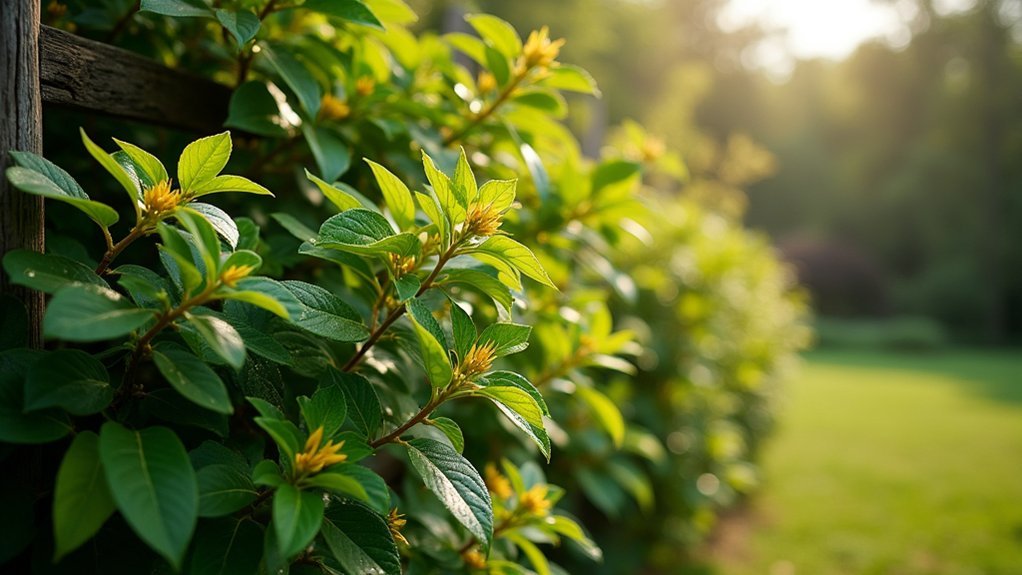
While many gardeners struggle with deer damage, Spicebush offers a fragrant solution that naturally keeps these foragers at bay. This deer resistant native shrub emits a strong aromatic scent that deer find unappealing, creating an effective natural barrier around your property.
Reaching 6 to 12 feet in height and width, Spicebush (Lindera benzoin) provides excellent coverage when planted as a fence border. You’ll enjoy its early spring yellow blooms that attract pollinators while deterring deer.
What’s more, it’s incredibly adaptable, thriving in various soil conditions and tolerating both sun and shade.
Beyond deer protection, you’re also supporting local wildlife – Spicebush berries feed birds, enhancing your garden’s biodiversity.
This versatile native offers the perfect combination of functionality and ecological value for your landscape.
American Beautyberry: Colorful Defense for Boundary Lines
For gardeners seeking boundary protection beyond aromatic deterrents, American Beautyberry (Callicarpa americana) offers a visually stunning alternative. This native shrub creates an effective natural fence, growing 3-6 feet tall and 4-5 feet wide with foliage deer tend to avoid.
You’ll appreciate its adaptability to various soil types and light conditions, thriving in both full sun and partial shade throughout USDA zones 6-10.
The shrub’s dense growth pattern provides excellent privacy while supporting local wildlife with shelter and food from its vibrant purple berries.
Once established, you’ll find American Beautyberry requires minimal maintenance and withstands drought conditions well.
Its practical benefits combine with ornamental appeal, making it an ideal choice for creating beautiful, deer-resistant boundaries along your property lines.
Viburnum Species: Tough-Leaved Natives for Perimeter Planting
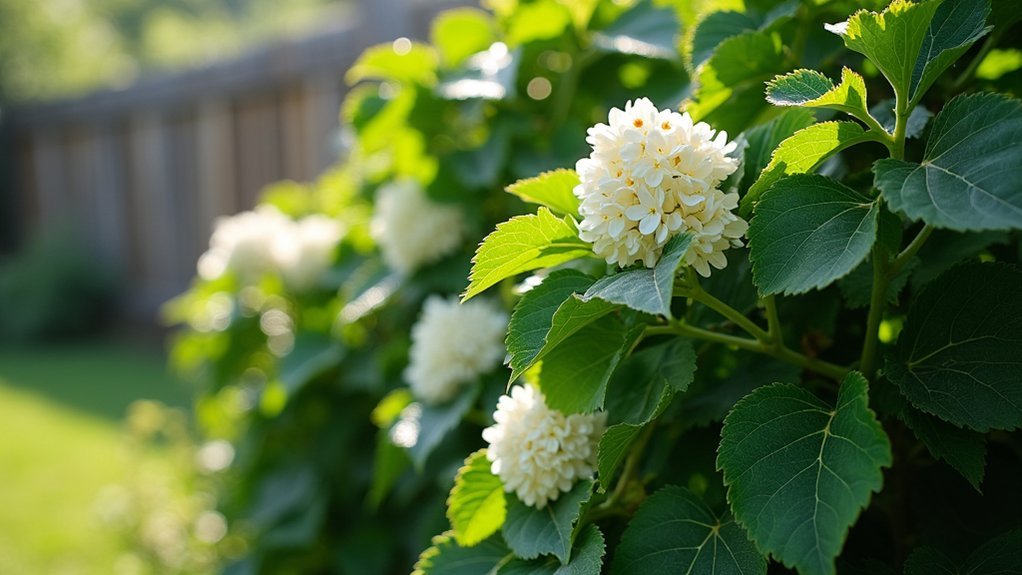
When seeking sturdy deer-resistant options for your landscape borders, Viburnum species stand out as exceptional choices with their tough, leathery leaves that naturally discourage browsing.
These versatile natives offer year-round interest with showy flower clusters, colorful berries, and stunning fall foliage.
Adaptable to zones 3-9, Viburnum species thrive in various soil conditions, making them perfect for challenging planting sites.
Popular varieties like Viburnum dentatum and Viburnum trilobum create effective natural barriers with their dense growth habit, effectively blocking unwanted wildlife access to your garden.
You’ll appreciate that many Viburnum species are self-pollinating, ensuring reliable berry production without needing multiple plants.
This characteristic not only enhances your landscape’s beauty but also provides valuable habitat for beneficial birds and pollinators.
Eastern Red Cedar: Evergreen Protection Year-Round
Eastern Red Cedar stands as a powerhouse among deer-resistant natives, offering protection that doesn’t disappear when winter arrives. This impressive evergreen grows up to 40 feet tall and 20 feet wide, creating a substantial living barrier for your property boundaries.
You’ll appreciate the Eastern Red Cedar’s aromatic foliage that naturally deters deer while providing dense coverage that birds love for nesting and shelter.
It’s remarkably adaptable, thriving in various soil types without demanding special attention once established.
What makes this shrub particularly valuable is its hardiness across USDA zones 2-9, ensuring your privacy screen remains intact regardless of harsh weather conditions.
When you’re looking for a low-maintenance, drought-tolerant option that contributes to local biodiversity, Eastern Red Cedar delivers year-round performance.
Bayberry Shrubs: Waxy Leaves That Deter Browsing

Nature’s remarkable design gives bayberry shrubs a built-in defense system against hungry deer. Their waxy leaves contain resinous compounds that deer find unpalatable, making them an excellent choice for your garden’s perimeter.
Bayberry shrubs thrive in USDA zones 3-6 and can grow 5-10 feet tall and wide, creating an effective privacy screen while keeping deer at bay. You’ll appreciate their dense growth habit that forms a natural barrier around your property.
Beyond deer resistance, these versatile shrubs contribute to your garden’s biodiversity by producing aromatic berries that attract birds and beneficial pollinators.
When you’re looking for a multi-purpose solution that combines deer deterrence with ecological benefits, bayberry shrubs offer the perfect balance of protection and environmental value.
Inkberry Holly: A Dense Evergreen Alternative to Boxwood
Inkberry Holly stands out as another excellent deer-resistant option for your landscape, offering the refined appearance of boxwood without the appetizing appeal to wildlife.
Unlike Butterfly Bush or Twig Dogwood, this native plant provides year-round color with its glossy, dark green foliage that remains vibrant regardless of the time of year.
Glossy, dark green foliage creates year-round visual interest where seasonal bloomers like Butterfly Bush simply cannot compete.
You’ll appreciate how this versatile evergreen shrub thrives in both full sun and part shade, growing 5-8 feet tall when mature.
While Japanese pieris offers similar deer resistance, Inkberry Holly’s adaptability to wet conditions makes it ideal for challenging areas in your local garden.
The small white flowers attract pollinators, while the black berries that follow provide food for birds.
For privacy fences or defined borders, few flowering shrubs match Inkberry’s dense growth habit and resilience against large deer populations.
New Jersey Tea: Compact Native for Lower Fence Lines
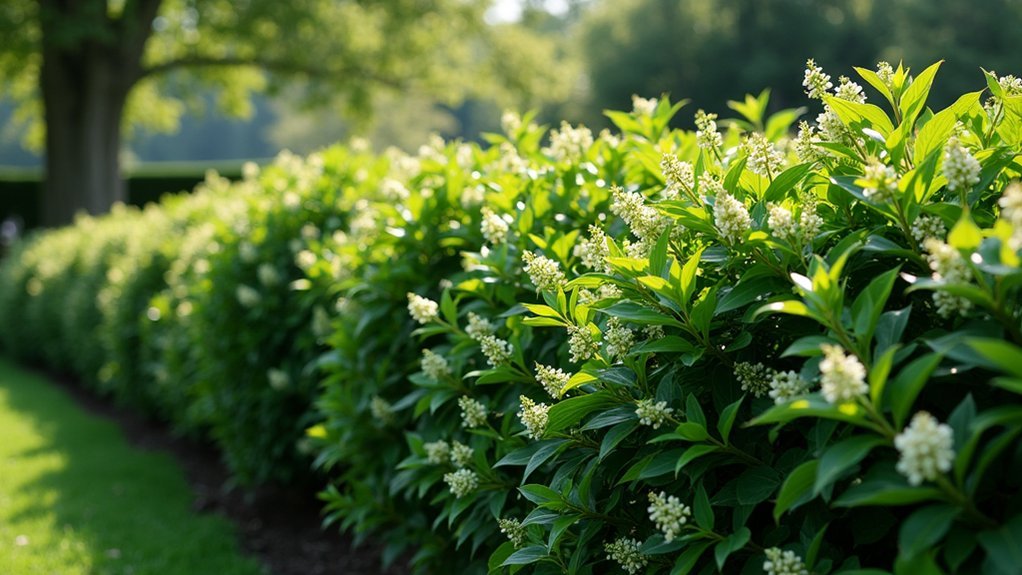
When looking for a shorter shrub to line your property borders, New Jersey Tea offers the perfect solution for homeowners battling persistent deer damage. This deciduous native grows just 2-3 feet tall, making it ideal for lower fence lines without blocking views.
You’ll appreciate its fragrant white flower clusters that bloom in late spring, attracting beneficial pollinators to your landscape. The aromatic leaves naturally repel deer, saving you the frustration of browsing damage.
New Jersey Tea thrives in well-drained soils and adapts easily to sandy or rocky sites common throughout New Jersey. Its low-maintenance nature means you’ll spend less time on upkeep while still supporting local biodiversity.
Plant this compact shrub along your property boundary for a beautiful, wildlife-friendly barrier that deer will avoid.
Elderberry: Multi-Season Interest With Deer Resistance
For homeowners seeking year-round visual interest with reliable deer resistance, elderberry stands out as an exceptional native shrub choice. This versatile Sambucus canadensis grows 6-8 feet in both height and width, making it ideal for natural fence lines and property boundaries.
You’ll enjoy clusters of delicate white flowers in spring that transform into deep purple berries by late summer. These berries aren’t just ornamental—they’re wildlife magnets, attracting beneficial pollinators like butterflies and bees to your garden.
One of elderberry’s most practical benefits is its natural deer resistance. The plant’s distinctive scent and taste keep browsers at bay, protecting your landscape investment.
Hardy in zones 5-7 and adaptable to various soil conditions, you’ll find elderberry thrives with minimal maintenance while providing maximum protection from deer damage.
Arrowwood Viburnum: Sturdy Structure for Natural Boundaries
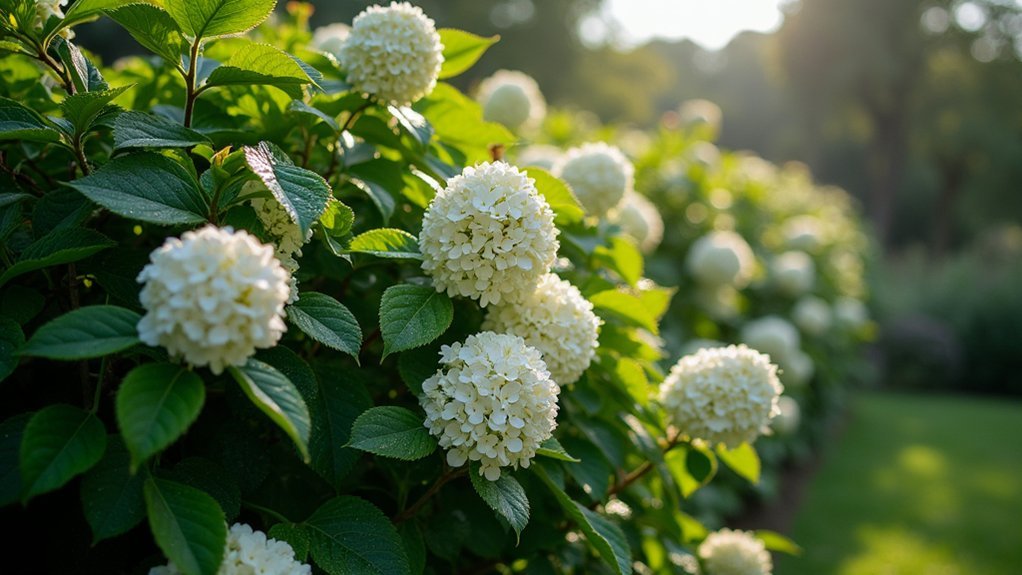
Creating sturdy natural boundaries around your property requires strategic plant selection, and Arrowwood Viburnum stands as one of the most effective choices available. This adaptable native shrub grows 5-10 feet tall with dense foliage that naturally deters deer while providing privacy.
You’ll appreciate Arrowwood Viburnum’s versatility across USDA zones 3-8, where it thrives in various soil conditions—even wet areas that challenge other plants.
In spring, its clusters of white flowers transform your boundary into a visual delight, later producing blue-black berries that attract birds and enhance your garden’s biodiversity.
If you’re looking to establish a natural fence that serves multiple purposes, this deer-resistant shrub delivers both protective structure and ecological benefits without sacrificing aesthetic appeal.
Wild Hydrangea: Shade-Loving Barrier Plants
Shaded areas in your garden need not remain vulnerable to deer intrusion, as wild hydrangea (Hydrangea arborescens) offers an ideal solution for these challenging spots.
This native shrub thrives where other plants struggle, creating dense barriers that reach 3-6 feet in height and width.
You’ll appreciate how deer avoid these plants due to their unpalatable foliage, while you’ll enjoy the spectacular white flower clusters that appear each summer.
These blooms not only enhance your landscape but also attract beneficial pollinators to your garden.
Wild hydrangea’s summer blooms transform your shade garden while creating a buzzing sanctuary for essential pollinators.
As a resilient native adapted to USDA zones 3-9, wild hydrangea contributes to local biodiversity while requiring minimal maintenance.
It adapts to various soil conditions, making it a practical choice for establishing natural, deer-resistant boundaries in shaded environments.
Frequently Asked Questions
What Are the Best Shrubs That Deer Won’t Eat?
You’ll find deer won’t eat viburnum, boxwood, butterfly bush, forsythia, and junipers. They’re resistant due to their tough textures, aromatic foliage, or unpalatable qualities, making them excellent choices for your garden.
What Is a Natural Fence for Deer Resistant?
A natural fence for deer resistance uses dense, thorny shrubs like Barberry and Black Locust. You’ll want to create a layered barrier at least 5-8 feet tall, incorporating fragrant plants that deer don’t like.
What Native Plants Repel Deer?
Native plants that repel deer include Viburnum, Butterfly Bush, Junipers, Boxwoods, Barberry, and Dogwood varieties. You’ll find these effective due to their aromatic qualities, tough textures, or bristly foliage that deer don’t enjoy browsing.
What Is the Fastest Growing Deer-Resistant Evergreen?
Eastern Red Cedar grows fastest at up to 24 inches yearly. You’ll find it’s extremely deer-resistant due to its aromatic foliage. Mugo Pine is another quick option, growing 12-18 inches annually while deterring deer.
In Summary
You’ll find these native shrubs create both beautiful and functional boundaries for your property while keeping deer at bay. By selecting plants that naturally resist browsing, you’re creating sustainable fencing solutions that support local ecosystems. Mix several varieties for year-round interest and maximum effectiveness. Remember, even deer-resistant plants may need protection when first established, but they’ll reward your patience with years of low-maintenance boundary definition.

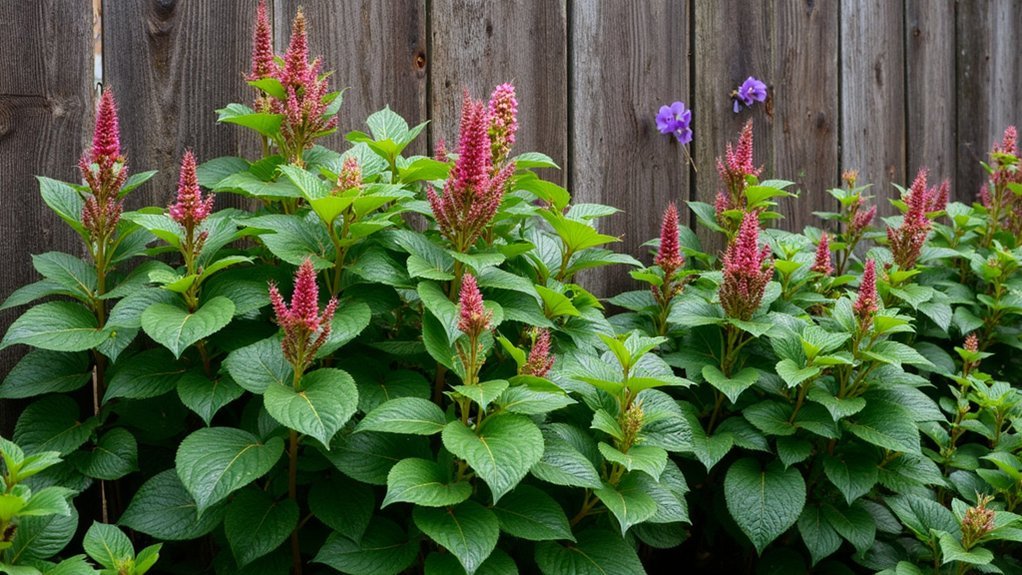



Leave a Reply